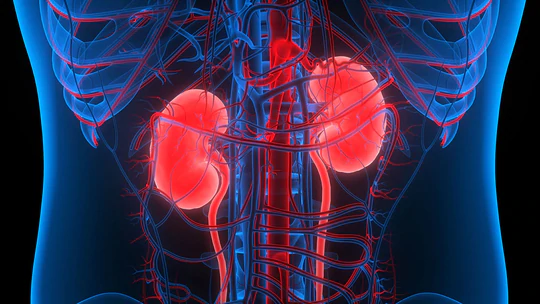NMN’s restoration of youthful kidney protein levels in aged mice may translate therapeutically to humans.
The world’s population of older adults continues to expand at an unprecedented pace. So, there is a need for a better understanding of aging processes to mitigate age-related diseases and disorders. But not all organs age at the same pace, so it’s important for scientists to characterize aging processes for each organ.
Recently, Deng and colleagues from Tsinghua University in Beijing published a study in Aging (Albany NY) where they examined changes within the cells of mouse kidneys during aging. They tested the effects of administering the molecule nicotinamide mononucleotide (NMN) on aged kidneys and found NMN helps to restore protein balance—proteostasis. This added understanding of how the aging process works in the kidney will facilitate the development of therapeutic options.
Older People are More Susceptible to Kidney Disease
Age-associated changes in the kidney include changes to the glomerulus, the critical cellular unit that filters waste products from the blood. The age-related decline in glomerulus function means a progressive decline in the waste filtration rate and, ultimately, loss of kidney function. This compromises the kidney’s ability to function after injury, leading to a higher susceptibility of older people suffering from kidney injury and disease.
Deng and colleagues looked at the effects of NMN on restoring kidney function during aging. They chose to investigate NMN because recent studies have shown that NMN supplementation may improve age-related organ dysfunction. NMN is a precursor to the vital molecule nicotinamide adenine dinucleotide (NAD+), which functions in cellular energy production and maintenance of DNA integrity. NAD+ levels decline with age in animals and people, a phenomenon that has been linked to age-related organ functional decline, including kidney dysfunction. Many studies show that NMN supplementation increases NAD+ levels in blood and various tissues of aged rodents, and scientists are testing whether NMN has these same effects in people.
Biomarkers that can Reveal the Age of Kidneys
Deng and colleagues searched for kidney aging biomarkers, protein levels indicative of kidney age. To do so, the researchers compared protein levels between young, eight-week-old and aged, ninety-six-week-old mouse kidneys, resulting in 7,208 proteins. To whittle this down, they compared these results to two datasets from other research groups and considered proteins present in blood or urine and also kidney tissue. This analysis left the researchers with just 27 biomarkers.
NMN Injections Restore Youthful Protein Levels
The scientists then injected aged mice with NMN every two days for four weeks, which restored proteins toward youthful levels. Of the 27 biomarkers, NMN supplementation reduced 16 of 19 of the proteins that increased with aging and increased six out of eight proteins with reduced levels in aging. This indicated that NMN restored kidney proteins toward youthful levels.
NMN supplementation also increased the number of cellular components called peroxisomes that break down waste products in cells. The team found that peroxisomes significantly decreased in number with age. NMN supplementation efficiently increased peroxisome numbers and also decreased cellular markers of kidney injury. In total, this suggests that NMN may protect against kidney injuries.
“We identified a set of proteins that were differentially expressed in young and aged mouse kidneys and might thus serve as biomarkers for renal aging,” stated Deng and colleagues in their publication. “In addition, our results showed that aging caused a reduction in peroxisomes, and that NMN administration restored the peroxisome homeostasis, suggesting NMN supplementation might be beneficial for kidney health.” They say their data provides a valuable resource for understanding age-related changes in the protein composition of the kidneys. This study also reaffirms the large-scale study of proteins—proteomics—as a powerful approach in aging studies.
Direction of Research on Aging Kidneys
Future studies will need to examine whether the levels of the 27 biomarkers identified in this study change in people with age. If so, this would mean that mouse proteomic analyses in aging could apply to human research. It will also be important to see whether NMN has the same effects in increasing peroxisome numbers in kidney cells and can protect aging people from kidney injury and disease.
Full Text Sources
